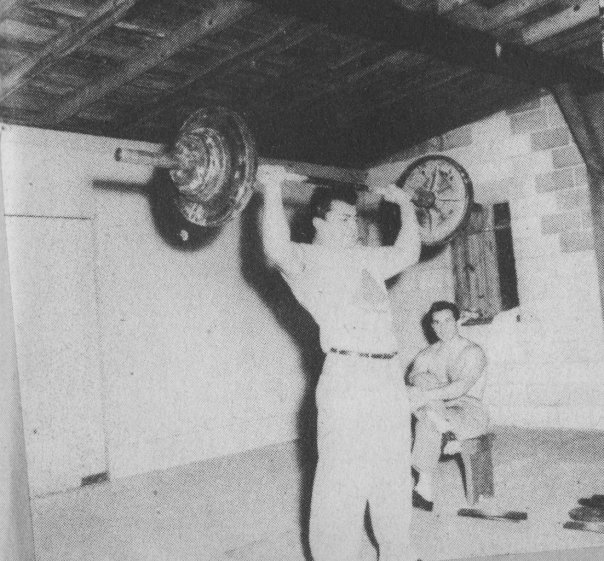

The Squat
The absolute best thing that you can do for your knees is to squat deep. By deep I mean to a depth where the femur, the thighbone, lies parallel to the floor. Merely getting the top of your thigh parallel to the floor is insufficient because most people have at least some muscle and and quite a bit of flesh around the thighbone. Proper depth can be achieved by making sure that the crease in your shorts near the hip is level with your kneecap. This is not only a safe depth but a healthy and functional depth at which to train the muscles about the knee.
In order to eliminate shearing force on the knee joint surfaces, muscular forces around the knee must be balanced. This means that all the muscles that attach at the knee should be contributing about equally all the way around, and the only way to make this happen is to squat deep. When you squat at or slightly below parallel, a funny thing happens that most instructors of group fitness--and most so-called personal trainers, in general--don't know about: the gluteus muscles and the hamstrings kick in to counteract the powerful quadracep muscles found at the front of the thigh. It also helps if you position your feet right at or slightly wider than shoulder width and you turn your feet out about thirty to fourty-five degrees.
There are several varieties of squats to choose from, but the most effective at making you strong and functional are the barbell back and front squats (the front squat is pictured above). Which squat you choose will determine the relative postitions of all of your levers--the arms, legs, spine, etc. However, whether you use the low-bar back squat or the front squat, you will always make sure that the barbell is kept over the midfoot as you squat because this is the most efficient way to move the weight, one in which the bar path remains vertical. You will find that, when front squatting, the back will stay close to vertical and the knees will travel a couple of inches forward of the toes, and that, when back squatting, the torso will be leaned forward about fourty-five degrees and the knees will travel a mere inch or so past the toes. Otherwise, just remember to keep the barbell over the midfoot.
Lastly, it is important that the spine keeps its lumbar (lower back) arch or, at a minimum, stays flat throughout because this keeps stress from passing on to the discs, the little cushions between the vertabrae. Also, a flat or slightly arched back more efficiently transmits force up the spine to the load being lifted, and with increased efficiency and safety, more weight can be lifted each workout as well as over time. And this has the potential to make you quite strong.
Having spent this much time and space discussing the safety and function of the correct squat, I suspect that I have also illustrated that exercise instruction takes (or should take) specialized knowledge and that not just anyone should be in charge of carrying you through or designing a workout. But alarmingly, a weekend seminar is most often all that it takes for some of these knuckleheads to get a job teaching at a gym near you, where "ineffective" or downright "unsafe" are the status quo. Take the squat again, for example. The half or quarter squat, which is the favorite of group exercise intructors, personal trainers and high school football coaches everywhere, actually increases the amount of shearing force on the knee joint. When squat depth is shallow, the hams and glutes don't engage to counteract the powerful quadraceps, which are trying like hell to slide the top surface of the tibia (shinbone) forward away from distal surface of the femur. Ouch! As the weight on the bar increases, so does the shearing force. Be afraid, gym-goers, be very afraid!
* * *
While I'm on the subject of effective training, I should direct your attention to the pictures above this post. I hope that I've made my point rather obvious. In addition to being an a$$hole, I'm implying that you might want to invest a little more time in your strength training. Since about the seventies, when the running phenomenon first swept the nation, the general population has come to regard running as the pinnacle of physical fitness. First of all, running is relatively easy to do compared to lifting because it requires no special skill at the recreational level, and because folks like to run outdoors, it is also the most visible form of exercise, two facts which explain, in large part, running's continuing popularity. Doctors will recommend running due to the ease with which it can be taken up by the general population and because they themselves know very little about actual weightlifting, not enough to prescribe it with any specificity, anyway.
And due to its popularity, running (and biking and swimming, too) has garnered much of the attention from researchers on fitness in the past three or more decades. What this means is that doctors and trainers will more often than not try to stretch what has been uncovered about endurance-type activities like running and apply it to strength training and weightlifting as if these are all the same things. But what if I told you that, in their furor to get people up and moving, these people have sentenced you to a set of practices that, while better than nothing, could actually cause you to age faster, get weaker and move more slowly?
More to come...

No comments:
Post a Comment